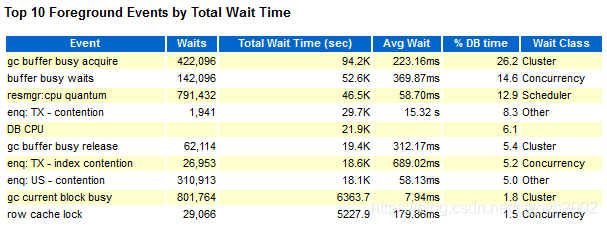os: 7.6 hundreds
db: Oracle 19.3
10G data usage swingbench amount of pressure to do testing, and then when you view the AWR reports, analyze the Top 10 Foreground Events by Total Wait Time.


buffer busy waits

10.3.2 buffer busy waits
This wait indicates that there are some buffers in the buffer cache that multiple processes are attempting to access concurrently. Query V$WAITSTAT for the wait statistics for each class of buffer. Common buffer classes that have buffer busy waits include data block, segment header, undo header, and undo block.
Check the following V$SESSION_WAIT parameter columns:
P1: File ID
P2: Block ID
P3: Class ID
Causes
To determine the possible causes, first query V$SESSION to identify the value of ROW_WAIT_OBJ# when the session waits for buffer busy waits. For example:
SELECT row_wait_obj#
FROM V$SESSION
WHERE EVENT = 'buffer busy waits';
To identify the object and object type contended for, query DBA_OBJECTS using the value for ROW_WAIT_OBJ# that is returned from V$SESSION. For example:
SELECT owner, object_name, subobject_name, object_type
FROM DBA_OBJECTS
WHERE data_object_id = &row_wait_obj;
Actions
The action required depends on the class of block contended for and the actual segment.
Segment Header
If the contention is on the segment header, then this is most likely free list contention.
Automatic segment-space management in locally managed tablespaces eliminates the need to specify the PCTUSED, FREELISTS, and FREELIST GROUPS parameters. If possible, switch from manual space management to automatic segment-space management (ASSM).
The following information is relevant if you are unable to use ASSM (for example, because the tablespace uses dictionary space management).
A free list is a list of free data blocks that usually includes blocks existing in several different extents within the segment. Free lists are composed of blocks in which free space has not yet reached PCTFREE or used space has shrunk below PCTUSED. Specify the number of process free lists with the FREELISTS parameter. The default value of FREELISTS is one. The maximum value depends on the data block size.
To find the current setting for free lists for that segment, run the following:
SELECT SEGMENT_NAME, FREELISTS
FROM DBA_SEGMENTS
WHERE SEGMENT_NAME = segment name
AND SEGMENT_TYPE = segment type;
Set free lists, or increase the number of free lists. If adding more free lists does not alleviate the problem, then use free list groups (even in single instance this can make a difference). If using Oracle RAC, then ensure that each instance has its own free list group(s).
See Also:
Oracle Database Concepts for information about automatic segment-space management, free lists, PCTFREE, and PCTUSED
Data Block
If the contention is on tables or indexes (not the segment header):
Check for right-hand indexes. These are indexes that are inserted into at the same point by many processes. For example, those that use sequence number generators for the key values.
Consider using ASSM, global hash partitioned indexes, or increasing free lists to avoid multiple processes attempting to insert into the same block.
Undo Header
For contention on rollback segment header:
If you are not using automatic undo management, then add more rollback segments.
Undo Block
For contention on rollback segment block:
If you are not using automatic undo management, then consider making rollback segment sizes larger.
Owi personally found that in practice the majority is because of a full table scan due.